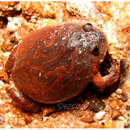en
names in breadcrumbs


Calluella guttulata is the type species of the small Southeast Asian genus Calluella, known as the squat frogs or burrowing frogs. This microhylid species is known by a variety of common names: Burmese Squat Frog, Orange Burrowing Frog, Striped Spadefoot frog, and Blotched Burrowing Frog.With the exception of C. minuta, which is endemic to and found only in a very limited tropical forested area of Pahang, Malaysia, Calluella guttulata is the only species in the genus that occurs in peninsular Southeast Asia. It inhabits mostly lowland areas of southern Myanmar, Malaysia, Laos, the Cardamom Mountains of southwestern Cambodia, Vietnam, and the northern Malay Peninsula.The other six members of the genus occur in China or Southeast Asian islands.
Burmese Squat Frogs appears to prefer disturbed areas and are most often observed along tropical and subtropical forest edges, degraded areas, trails and cultivated gardens though they also live in intact forest and marshes.A burrowing frog, Calluella guttulata has cryptic brown and red mottled coloration and a round body with short limbs.Its toes are not webbed, and the hind limbs have large flat protrusion under the foot used for digging.It sometimes occurs in large numbers after rains, when they emerge from their burrows to breed explosively in temporary puddles and ephemeral rain pools (where their tadpoles develop).
In Laos and Thailand people collect Burmese Squat Frogs for food.Although their habitat is shrinking in some parts of their range, they are not uncommon and do not have threatened status.Furthermore, their range overlaps several protected areas.
(Altig and Rowley 2014; Frost 2015; van Dijk and Stuart 2009)
Glyphoglossus guttulatus, also known as Burmese squat frog, blotched burrowing frog, orange burrowing frog, or striped spadefoot frog, is a species of frog in the family Microhylidae. It is found in Myanmar, Thailand, Cambodia, Laos, and Vietnam. It is uncertain whether it is present in the Peninsular Malaysia.[1][2]
Glyphoglossus guttulatus occurs in lowland forests at elevations of 150–400 m (490–1,310 ft) above sea level. It is most commonly observed on leaf litter near rivers. Breeding is explosive and takes place in water. The tadpoles are suspension feeders.[1]
This species can occur locally in great numbers during the breeding and then effectively disappear. It is probably threatened by habitat degradation caused by expansion of agricultural land, roads, and human settlements. It is harvested for human consumption in Laos and Cambodia. It has been recorded in a number of protected areas, and many more protected areas overlap with its predicted range.[1]
Glyphoglossus guttulatus, also known as Burmese squat frog, blotched burrowing frog, orange burrowing frog, or striped spadefoot frog, is a species of frog in the family Microhylidae. It is found in Myanmar, Thailand, Cambodia, Laos, and Vietnam. It is uncertain whether it is present in the Peninsular Malaysia.
Glyphoglossus guttulatus occurs in lowland forests at elevations of 150–400 m (490–1,310 ft) above sea level. It is most commonly observed on leaf litter near rivers. Breeding is explosive and takes place in water. The tadpoles are suspension feeders.
This species can occur locally in great numbers during the breeding and then effectively disappear. It is probably threatened by habitat degradation caused by expansion of agricultural land, roads, and human settlements. It is harvested for human consumption in Laos and Cambodia. It has been recorded in a number of protected areas, and many more protected areas overlap with its predicted range.